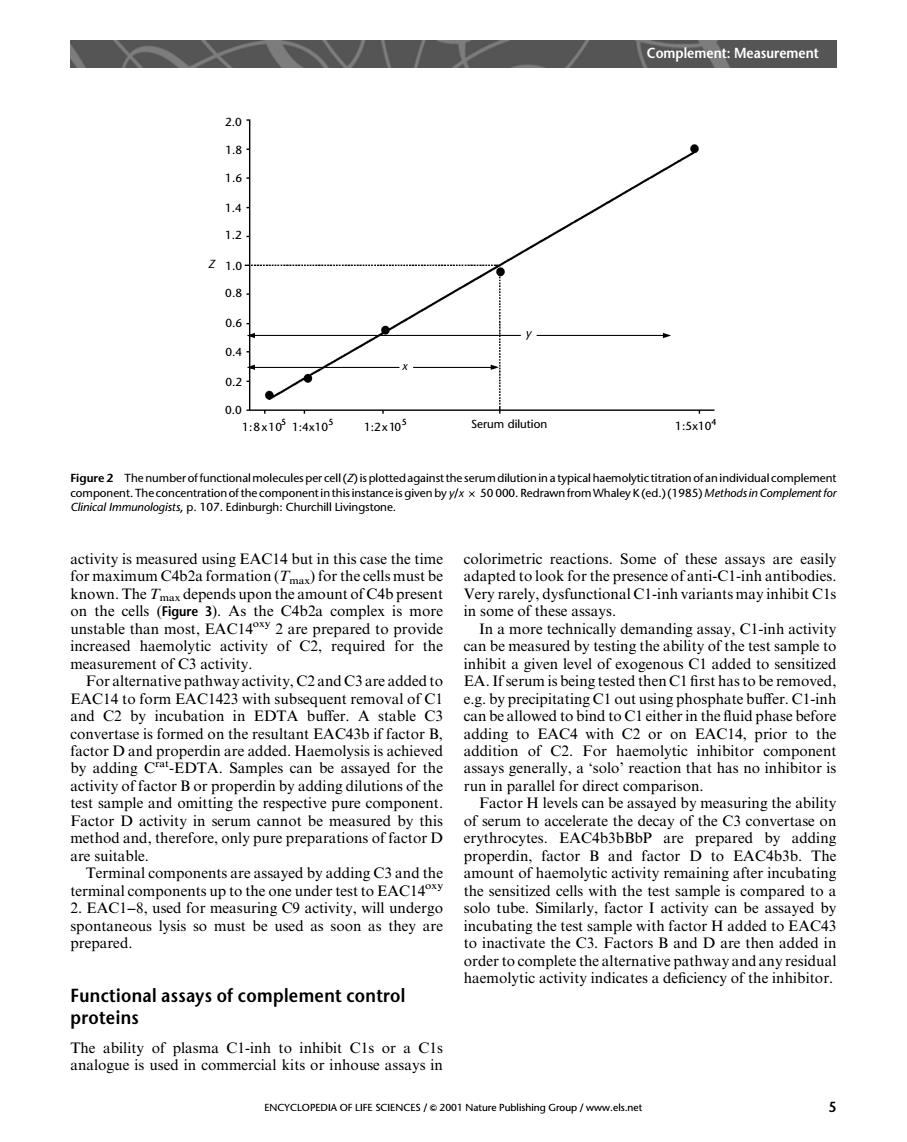正在加载图片...

Complement:Measurement 20 1.8 1.6 12 1.0 08 0.6 04 0.2 1:8x101:4x103 1-2x103 Serum dilution 1:5x10 Figure 2 nce forivity is measured using EACu n this case the time for max for the cells must be ineme e epared to provide In a more technically demanding assay.Cl-inh activity can be measured by testing the ability of the test sample to y.C2and C3areadded to a given level of exogenou -I adde【o sensitize 1 hu开 e Cl-inh and C2 by incubation in EDTA buffer.A stable C3 can to ind in he fuid phase before convertase is formed on the resultant EAC43b if factor B. add an EDTA.S e ad d8°4品5 is A,pnor o din by a adding dilutions of the run in allel for direet cor test sample and omitting the respective pure component FactorHlvels can be assayed by measuring the ability ecay of the C3 convertase on met are rep Th terminal components up to the one under test to EAC14xy the sensitized cells with the test sample is compared to a 2.EAC1-8.used for measuring C9 activity,will undergo us lysis so must be used ol tube.Similarly.activity can be aye le wit act prepare D dded in athu and anyr haemolytic activity indicates a deficiency of the inhibitor. Functional assays of complement control proteins The ability of plasma cl-inh to inhibit Cls or a Cls analogue is used in commercial kits or inhouse assays in 5activity is measured using EAC14 but in this case the time for maximum C4b2a formation (Tmax) for the cells must be known. TheTmax depends upon the amount of C4b present on the cells (Figure 3). As the C4b2a complex is more unstable than most, EAC14oxy 2 are prepared to provide increased haemolytic activity of C2, required for the measurement of C3 activity. For alternative pathway activity, C2 and C3 are added to EAC14 to form EAC1423 with subsequent removal of C1 and C2 by incubation in EDTA buffer. A stable C3 convertase is formed on the resultant EAC43b if factor B, factor D and properdin are added. Haemolysis is achieved by adding Crat-EDTA. Samples can be assayed for the activity of factor B or properdin by adding dilutions of the test sample and omitting the respective pure component. Factor D activity in serum cannot be measured by this method and, therefore, only pure preparations of factor D are suitable. Terminal components are assayed by adding C3 and the terminal components up to the one under test to EAC14oxy 2. EAC1–8, used for measuring C9 activity, will undergo spontaneous lysis so must be used as soon as they are prepared. Functional assays of complement control proteins The ability of plasma C1-inh to inhibit C1s or a C1s analogue is used in commercial kits or inhouse assays in colorimetric reactions. Some of these assays are easily adapted to look for the presence of anti-C1-inh antibodies. Very rarely, dysfunctional C1-inh variants may inhibit C1s in some of these assays. In a more technically demanding assay, C1-inh activity can be measured by testing the ability of the test sample to inhibit a given level of exogenous C1 added to sensitized EA. If serum is being tested then C1 first has to be removed, e.g. by precipitating C1 out using phosphate buffer. C1-inh can be allowed to bind to C1 either in the fluid phase before adding to EAC4 with C2 or on EAC14, prior to the addition of C2. For haemolytic inhibitor component assays generally, a ‘solo’ reaction that has no inhibitor is run in parallel for direct comparison. Factor H levels can be assayed by measuring the ability of serum to accelerate the decay of the C3 convertase on erythrocytes. EAC4b3bBbP are prepared by adding properdin, factor B and factor D to EAC4b3b. The amount of haemolytic activity remaining after incubating the sensitized cells with the test sample is compared to a solo tube. Similarly, factor I activity can be assayed by incubating the test sample with factor H added to EAC43 to inactivate the C3. Factors B and D are then added in order to complete the alternative pathway and any residual haemolytic activity indicates a deficiency of the inhibitor. 2.0 1.8 1.6 1.4 1.2 1.0 0.8 0.6 0.4 0.2 0.0 1:8x105 1:4x105 1:2x105 Serum dilution x y 1:5x104 Z Figure 2 The number of functionalmoleculesper cell(Z)is plottedagainstthe serum dilutionin a typicalhaemolytictitration of an individual complement component.The concentrationof the component in this instanceis given by y/x 50 000. RedrawnfromWhaleyK (ed.) (1985) Methodsin Complement for Clinical Immunologists, p. 107. Edinburgh: Churchill Livingstone. Complement: Measurement ENCYCLOPEDIA OF LIFE SCIENCES / & 2001 Nature Publishing Group / www.els.net 5